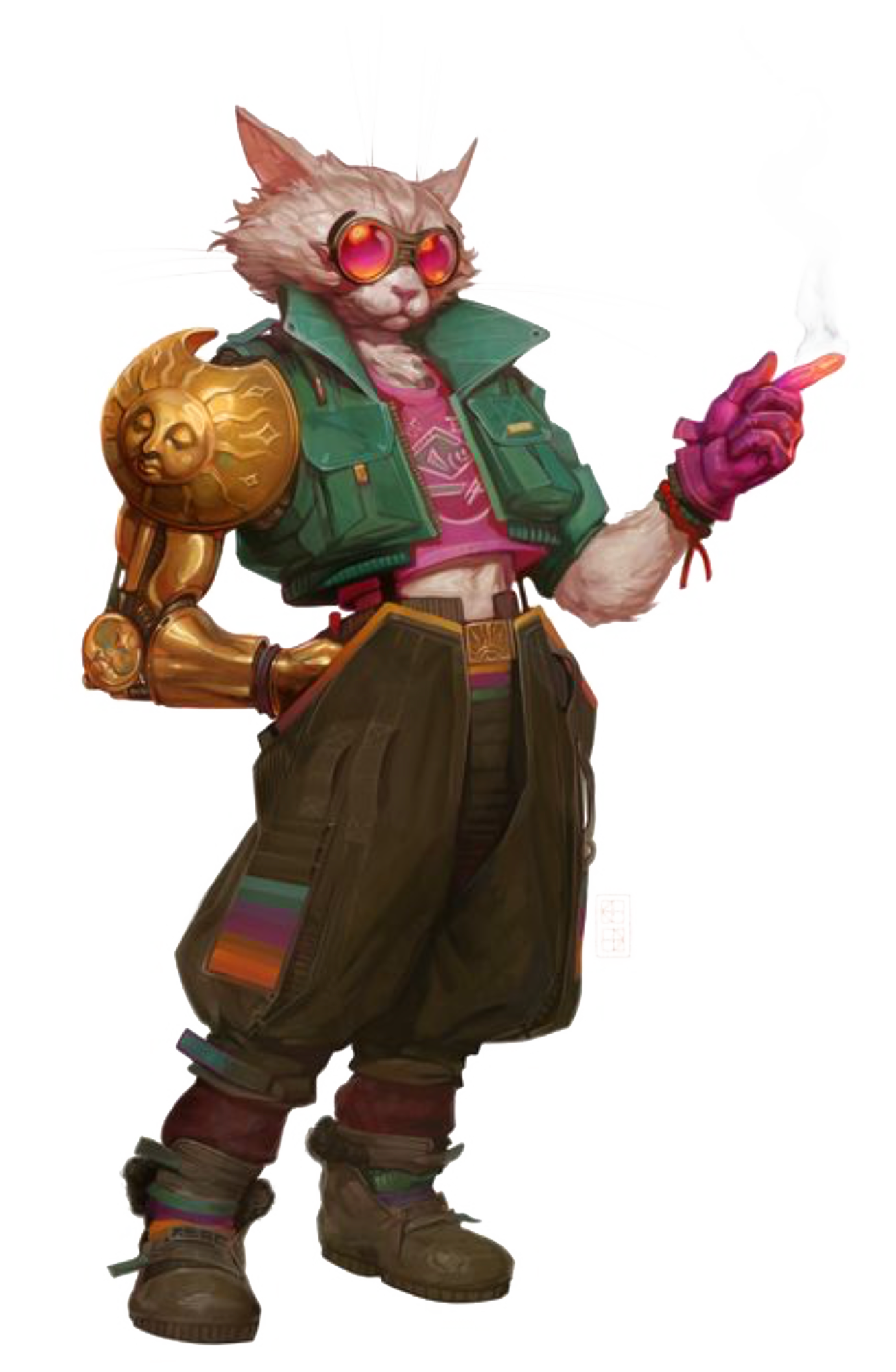Hello everyone! Starfinder team here and ready to give you a sneak peek into Starfinder Second Edition by giving you a preview of the solarian class! We’re sure you can’t wait to playtest it yourself once the Starfinder Playtest Rulebookreleases this August, but in the meantime, read on!
Dae, the iconic solarian
Art by Kent HamiltonOf course, we can’t talk about solarians without shining the spotlight on Dae, the new iconic solarian. In fact, Dae has already had their blog debut, and you can read all about them in our Meet the Iconics: Dae post from June. They’d appreciate it if you like, comment, and subscribe.
Solarians are solar knights who harness the powers of light and gravity to manifest powerful armaments in their quest to understand the cosmic forces of the universe.
Designing solarians for Starfinder Second Edition presented the team with an opportunity to reexamine the solarian toolset. In Starfinder First Edition, solarians had a key choice at first level when selecting whether their solar manifestation would be armor or a weapon. As the solarian leveled up, they chose stellar revelations, special powers they could use while attuned to gravitons or photons. Some powerful revelations could be used only if the solarian spent enough time building up their attunement points to become “fully attuned.” To match the mechanics to solarian beliefs about the cosmic cycle, First Edition solarians were encouraged to select an equal number of graviton and photon revelations.
With Starfinder Second Edition’s three-action economy in mind, the team took a new approach to solarians. We wanted the narrative of the Cycle to continue to match the mechanics while still offering solarians flexibility, both in their character build and in their round-by-round action economy. To that end, solarians in Second Edition don’t have to choose between armor or a weapon: from level 1, they can manifest a solar flare (ranged attack), solar nimbus(defensive reaction), and solar weapon (exactly what it sounds like—a melee attack). Each of these manifestations has a different function based on whether the solarian is graviton-attuned or photon-attuned.
So, what major choice do Second Edition solarians make at level 1? That’d be their solarian arrangement! All solarians have personal beliefs, practices, or training that cause them to gravitate (pun intended) toward a specific aspect of the Cycle, whether that’s gravitons, photons, or balance. This arrangement grants them revelations, which (like in First Edition) are special abilities that interact with the different states of attunement and, in many cases, interact with their targets’ Hit Point totals, enemy positioning, the solarian’s mobility, and so on.
Okay, so if solarians choose a solarian arrangement that focuses on gravitons, are they going to spend all their time attuned to gravitons? Doesn’t that go against the narrative of the “Cycle” and balance between stellar forces? This is where we’ve made what is possibly the biggest change to solarians: their attunement works differently now. Gone are the days of tracking attunement points: you’re either attuned to gravitons, photons, or neither. Furthermore, we’ve introduced a new type of ability: those with the cycle trait, which—you guessed it—cycle your attunement! Using a cycle ability while graviton-attuned means that you resolve that ability (applying any additional effects from being graviton-attuned), and then immediately become photon-attuned. If you want to be graviton-attuned again, you’ll need to use another cycle ability or take the Attune action, which attunes you to your favored attunement state. If you want to play a solarian who does lots of attunement swapping and has greater attunement flexibility, you’ll want the “balanced” solarian arrangement, because (among their other fun abilities) the Attune action lets you pick either graviton or photon!
This round-by-round decision-making process based on each ability’s unique attunement effects has played out quite well in both internal and public playtests, and we can’t wait for you to try it out. Players seem to enjoy the rush of cycling between graviton and photon attunement, and the “combos” they can create with a solarian’s abilities. You might not need to take the Attune action during combat at all if you’re intentional about how and when you use your cycle abilities, but if you really want to make an impact, you’ve got another exciting new type of ability: actions with the disharmony trait have a big effect, then completely end your attunement. You’ll need to spend an action to Attune again after using a disharmony ability—otherwise, you can’t manifest your solar shot, nimbus, or weapon. Then again, by that point, the battle might be over!
Okay, we’ve talked about the cool things solarians can do, but one big question we get a lot is how solarians will work as primarily melee-focused characters in an otherwise ranged-combat “meta.” We’ve mentioned their solar flare, a fun way to attack enemies at a short distance; it’s a great ability to fire off while closing the gap. Speaking of closing the gap, solarians have a plethora of options when it comes to battlefield positioning, whether that’s gaining a big speed boost or taking a more direct approach and moving enemies around with gravity powers. You might need to work a little harder than the sniper in your party when it comes to tactical positioning, but the cinematic combos you can pull off while getting into position will be a blast! If you’re worried about what might happen to your Hit Points while you’re moving in, you’ve got options there, too: Solar Shield, a level 1 feat, allows you to manifest a stellar shield that floats nearby. You’ll also likely have a decent AC and a fair number of Hit Points to rely on. Because your key attribute is Strength and the damage of your primary ranged attack (solar flare) uses Strength as well, you’ll likely be able to make room in your build for attribute boosts to Dexterity, Constitution, or both!
We’re excited to see what kinds of solarian builds you create during the playtest. In our own internal playtesting, we’ve built solarians who focus on big speed boosts to get in close and deal tons of damage, others who stay in the front lines to fight like a tank, and still others who pin enemies down as masters of battlefield control. Every solarian we’ve playtested has felt different. Most importantly, though, each of them has felt very much like a solarian.
Remember to keep an eye on the Starfinder Playtest site for more news and info about the playtest and feedback process. We’ll have lots more Starfinder Second Edition news to announce at GenCon 2024, when you’ll finally be able to purchase the Starfinder Playtest Rulebook (or download the free PDF)!
— The Starfinder Team
Read more at this site

